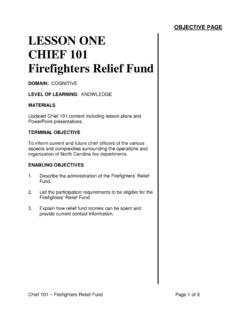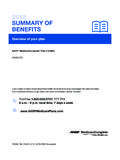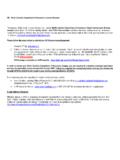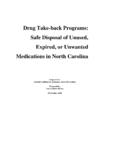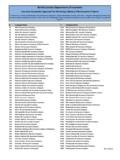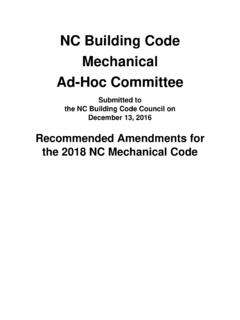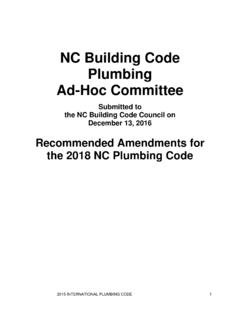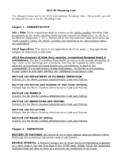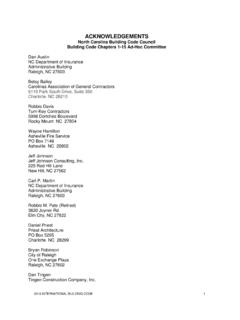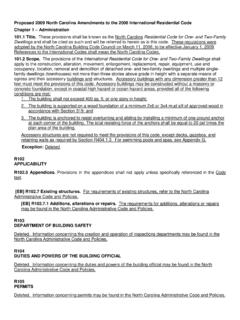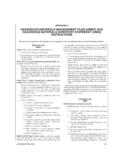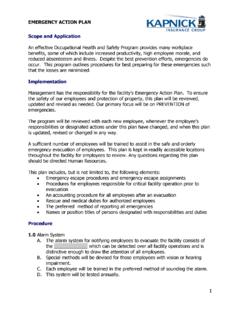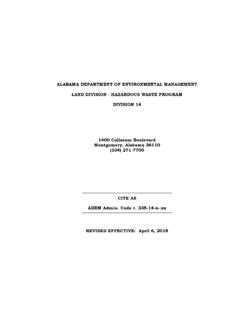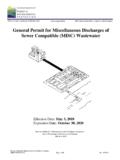Transcription of NCDOI OSFM Evaluation Services
1 WP-058-11 hazardous Materials Best Practices Page 1 of 15 NCDOI osfm Evaluation Services Scope of DOI White Paper: The Purpose of this document is to provide clarification and suggested best practices on North Carolina State Code requirements to Code Enforcement Officials (CEO) who are agents for the Authority Having Jurisdiction (AHJ). DOI File #: WP-058-11 Edition Date: January 25, 2013 Subject of White Paper: Plan Review for Buildings Containing hazardous Materials. Table of Contents Intent .. 1 Code References .. 2 North Carolina Code Requirements, Required Submittals and Permit Requirements .. 2 A. Code Requirements .. 2 B. For Submittal to Fire Code Official .. 3 C. For submittal to Building Code Official: .. 3 hazardous Materials and Plan Review .. 3 A. HMEX: The hazardous material Expert Assistant report .. 4 B. MSDS Sheets .. 4 C.
2 Examples of hazardous material Worksheets .. 5 D. hazardous material Evaluation process .. 5 Inspections .. 8 Resources .. 9 Appendix A- Definitions .. 10 Note: Words appearing in italics throughout the document are defined in Appendix A. Intent To introduce code requirements for hazardous materials (HAZMAT). The building codes categorize hazardous materials as liquids, solids or gases which pose a physical and/or health hazard. The codes address hazardous materials as a threat to property and life safety because they are commonly associated with being flammable, combustible, oxidizing, unstable/reactive, or toxic. These materials can be responsible for a number of challenges during an emergency including reduced time for evacuation and accelerated spread of fire. In addition to the obvious goal of limiting exposure to the occupants of a building from the negative properties of hazardous materials, it is important to recognize the potential threat to first responders in a building containing hazardous materials.
3 Responding to an emergency event involving unexpected hazardous materials can be one of the most dangerous situations a first responder may face. Without the properly planned response measures and equipment, there is an elevated risk of injury, exposure or death to both the responders and the public. To ensure WP-058-11 hazardous Materials Best Practices Page 2 of 15 the responders are prepared for what they may face, accurate and current information is needed on materials located in a building and the associated hazards. hazardous substances are to be stored and handled in a way that minimizes the risks posed by those substances and which limits exposure to them. When identifying a hazard associated with a material , a material Safety Data Sheet (MSDS) is prepared. Similar to the criteria used in NFPA 704, A MSDS will quantify the hazard associated with a material so that the material can be properly classified and hazardous condition can be mitigated.
4 HAZMAT issues are often associated with laboratory or research buildings, but they can also be encountered in areas such as those used for heavy equipment repair, museum display, theater prop fabrication, prison enterprises, print shops, manufacturing facilities and storage of tires, paint, finishing materials, swimming pool supplies, farm chemicals, and petroleum products, among many others. Most people encounter hazmats every day without being fully aware of the elevated risk they are exposed to. Places such as a service station or a hardware store or paint store must be evaluated for hazardous materials to ensure that minimum life safety requirements of the code are implemented. Code References A. Unless otherwise stated, all code references are to the 2012 North Carolina State Building Codes (NCSBC). B. North Carolina Building Code (NCBC) applicable portions include but are not limited to: 1.
5 Chapter 3, Section 307 and Tables (1), (2) 2. Chapter 4, Section 414, 415 and Tables , , C. North Carolina Fire Code (NCFPC) applicable portions include but are not limited to: 1. NCFPC, Chapter 18, Tables , 2. NCFPC, Chapters 27 through 44. 3. Appendices E and F North Carolina Code Requirements, Required Submittals and Permit Requirements A. Code Requirements- NCBC, Section 414 and NCFPC, Section 2701contain the requirements the Building official and the designer need to consider when designing for and reviewing for hazardous materials. They include: 1. Where and how the material is to be used and stored 2. material type and classification 3. Quantity of materials in each individual room or space or control area 4. Special requirements based on the specific material 5. Location of control areas (See Appendix A for definitions) 6. Rating of fire barrier construction between control areas 7.
6 Type of fire alarm system and automatic smoke detection 8. Type of sprinklers or other fire suppression systems 9. Types of ventilation, mechanical and electrical systems with emergency or stand-by power 10. hazardous material Management Plan (HMMP) - NCFPC, Section This plan is to contain the following information: Access to each storage and use area Location of emergency equipment WP-058-11 hazardous Materials Best Practices Page 3 of 15 Location where liaison will meet emergency responders Facility evacuation meeting point locations The general purpose of other areas within the building. Location of all above-ground and underground tanks and their appurtenances including, but not limited to, sumps, vaults, below-grade treatment systems and piping. The hazard classes in each area. Locations of all control areas and Group H Occupancies. Emergency exits.
7 11. hazardous material Inventory Statement (HMIS) - NCFPC, Section This statement is to contain the following information: Product name. Component. Chemical Abstract Service (CAS) number. Location where stored or used. Container size. Hazard classification. Amount in storage. Amount in use-closed systems. Amount in use-open systems. 12. Permits shall be required as per NCFPC, Sections , through Mandatory permits Optional permits See Table for permit amounts for hazardous materials. B. For Submittal to Fire Code Official: 1. Construction documents as per NCFPC Section 2. The HMMP as required by the Fire Code Official 3. The HMIS as required by the Fire Code Official C. For submittal to Building Code Official: 1. Construction Documents as per 2012 NC Administrative Code and Policies (NCACP, Section 104). These documents are to include floor plans showing location of all materials, storage cabinets if applicable, contents and processes, and fire-ratings of walls, floors, ceilings.
8 2. Information is to be provided to determine if the building or any part of the building will be classified as hazardous Occupancy or require control areas. 3. Locations of hazardous storage areas, and how each location will be protected are to be shown on the plans. 4. Opinion and report, as stated in NCBC, Section , .. prepared by qualified person, firm or corporation approved by the building official .. shall be provided to the enforcing agency. hazardous Materials and Plan Review The Code establishes a threshold when the quantity of a hazard material represents an extraordinary hazard and may cause the re-classification of a use group. Recognizing these thresholds is important in the early part of a project because they can enable the building owner WP-058-11 hazardous Materials Best Practices Page 4 of 15 to better estimate construction, operation and maintenance costs.
9 Mitigation of these hazards may include reduction in material quantity or change of material , rated separations, and installation of approved storage cabinets to increase the maximum allowable quantities of materials in a building. Information such as the types of hazardous materials, quantities, storage arrangements, and rated assemblies are very important at the schematic stages of plan review. The Building Department and/or Fire Marshal s office should have hazardous material classification resources on hand to effectively evaluate the validity of the design of a structure where hazardous materials will be stored or used. Examples include: A. The hazardous material Expert Assistant report (HMEX)- this program is available from the ICC store. #longdesc 1. The bullets below are from the ICC website and explain the HMEX program: Hazard classifications and definitions are correlated with the IFC and IBC.
10 Chemicals can be identified from a classified database. The data can be accessed by chemical name, synonym, partial name, CAS registration number, or RTECS number, includes physical and chemical properties. The physical state of the material along with code identified physical and health hazard properties are included. Methodology developed by FEMA/DOT/EPA first published in the 1990 Handbook of Chemical Hazard Analysis Procedures allows the user to screen the consequences of the inadvertent mixing of two materials. It is available on CD-ROM in a Microsoft Windows compatible single-user version. 2. The Building Department Code Enforcement and/or Fire Marshal s staff may require additional information for verification of code compliance or equivalence. The additional information is necessary to ensure that all risks to the public or to the emergency responders are addressed in the design and occupancy of the facility where the materials are present.
